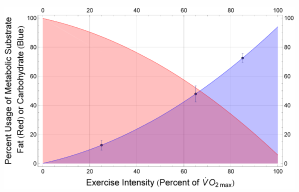In short, the thinking goes something like this. The reason we should do a long weekly run is to force the body to learn to burn more fat by first depleting its supply of glycogen.
As depicted in the accompanying graph (copied from the article), at faster speeds, we burn more carbohydrates and at slower speeds, we burn more fat. Thus, if we run slowly on our long runs, we’ll never actually deplete our carbohydrate supply. This suggests that there are really only two practical ways to get to a state of carbohydrate depletion and start straining our fat burning: (1) do your long runs first thing in the morning on an empty stomach or (2) do long fast runs. Remember, the idea is to put the body in a state of crisis and force it to start burning fat.
I can’t imagine that I would ever recommend either of these workouts to anyone but the fittest of athletes– and then only if they have a long time to recover. First, when the body gets depleted of carbohydrates and enters into this crisis mode, it does burn more fat– but it also starts cannibalizing our own muscle protein for fuel. Second, coordination and biomechanics go right out the window at that point, so there’s a much greater risk of injuries. Third, this isn’t just “burning a match”– this is lighting up the matchbook and burning down the house. Few things make me want to hang up my running shoes for good more than bonking (or even coming close to bonking). Finally, even if I had a will of steel and a body that could withstand the muscle breakdown, it still takes a ton of time to recover from glycogen depletion at this level.
If you’re familiar with programs like New Leaf metabolic testing, you’ve probably seen charts like the one above. Those programs take an entirely opposite approach by recommending training at very moderate paces. In theory, the idea is to push the red curve (fat burning) up and to the right and to push the blue curve (carbohydrate burning) down and to the right– the end goal being that, at any given speed, more of you energy is coming from fats. I know many folks who swear by this approach, but not many of them are terribly fast and all of them tend towards longer events. The problem I have with these programs is that it often takes a heck of a lot more time doing low intensity work than they tell you it does. If I had to run 2-3 hours or ride 5-6 hours every single day, it’s certainly a sound approach but I don’t know of too many age group athletes with that much time on their hands.
Bottom line: I’m highly suspicious of both methods of training your body to burn more fat than carbohydrates.
